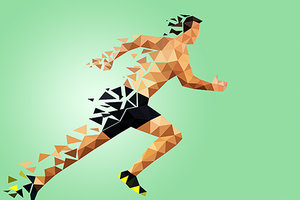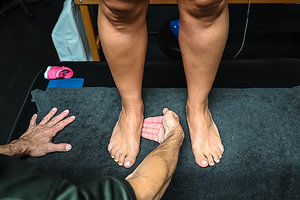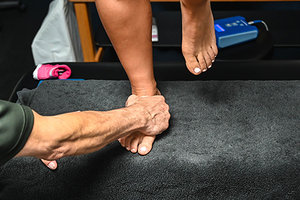Determining the best chiropractic regimen for a patient always begins with a comprehensive exam. Of course, this involves obtaining a complete medical history while also asking about any current issues they may be experiencing. Yet there's one evaluation that should be added to a sports DC's examination process; it involves taking an in-depth look at the patient's lower body.
Why Lower-Body Alignment Is So Important in Sports Chiropractic
Oftentimes, the lower body structure is the determinant of many remote musculoskeletal and nervous system conditions. Since the foot can be viewed as the foundation of the body, if the biomechanics are ever-so-slightly aberrant, the rest of the system can be disrupted and the weakest link in that system can eventually manifest an injury.
 This is especially true for athletes. Can a mild, undiagnosed, left-sided "turf toe" in a baller cause a right-sided suboccipital headache? Certainly!
This is especially true for athletes. Can a mild, undiagnosed, left-sided "turf toe" in a baller cause a right-sided suboccipital headache? Certainly!
Joint range-of-motion limitations in one area will always cause overuse or increased ranges in another joint(s) to achieve the same outcome. An example of this is loss of range in the right foot. Dorsiflexion may result in over-abduction and extension of the left shoulder in an effort to catch an overhead pass.
Ideal for Every Active Patient
Conducting a thorough lower-body evaluation on active patients leads to accelerated and accurate diagnostic and treatment protocols. This results in faster and more heightened injury resolution. It also provides a greater potential for peak performance results. (For paid athletes, this can translate to extended and lucrative contract negotiations.)
While all of this is good for the patient, it is also good for the doctor. Your ability to improve healing and increase performance leads to more referrals. You develop a sophisticated and prolific reputation as the sports DC who delivers results.
Plus, this is such a simple approach that it can be rendered to any and all active individuals. This reduces the necessity of having to pick and choose who is best suited for this exam. It becomes part of every evaluation, providing a more complete picture of your patient's health and potential obstacles.
The "69 Solution"
I call this approach the "69 solution" because if you turn both numbers on their side, the top number represents a cross-section of the patient's foot (the medial longitudinal arch consisting of the navicular, cuneiform and first metatarsal; the lateral longitudinal arch consisting of the 5th metatarsal, cuboid, and calcaneus). The bottom number is your hand and fingers, offering support for the foot's arch.
 A cursory approach to determining the extent of pes planus.
Typically, the exam starts with the patient unknowingly being studied while executing their natural biomechanics during the act of walking into the exam room. The formal physical exam begins with the barefooted patient walking in place for five seconds.
A cursory approach to determining the extent of pes planus.
Typically, the exam starts with the patient unknowingly being studied while executing their natural biomechanics during the act of walking into the exam room. The formal physical exam begins with the barefooted patient walking in place for five seconds.
Observe their static posture (head carriage, shoulder height, torso position, hip height, and knee position – in full extension or not). Also observe the feet (symmetry, arch, Achilles tendon, heels, big toe, nails, vascularity, muscle development, etc.).
 Have the patient perform a single-leg squat. If knee pain resolves, then consider biomechanical taping of the arch or install an arch support.
Remember that all of this data is just one piece of a huge puzzle. Your role as "detective" is to gather or reject each piece of data to develop a more complete clinical picture and convict "the perpetrator of the crime," finding the offending issue so as to also decide the best way to resolve it.
Have the patient perform a single-leg squat. If knee pain resolves, then consider biomechanical taping of the arch or install an arch support.
Remember that all of this data is just one piece of a huge puzzle. Your role as "detective" is to gather or reject each piece of data to develop a more complete clinical picture and convict "the perpetrator of the crime," finding the offending issue so as to also decide the best way to resolve it.
One of the frequent examples presented in our office is chronic, acute exacerbation of knee pain. This includes sprains of the medial collateral, anterior cruciate ligament (ACL), and vastus medialis oblique (VMO). Many providers have worked on the knee with marginal improvement and transient resolution.
A simple, yet effective trick is utilizing the single-leg squat to reproduce the pain at the knee. During this exercise, the practitioner typically places a hard foam arch support under the bare foot. Another alternative is to place your fingers firmly under the arch, and then have them reproduce the single-leg squat.
Nine times out of 10, the patient sighs with instant relief from the painless action. You're told that you're a genius, to which I generally respond with, "Nah, it's the magic wand"; or in this case, it was my hand and fingers adequately supporting their arch.
This exam can provide guidance in an appropriate selection of footwear for the athlete patient. It also serves as a foundation for recommendations to purchase a padded arch support from the local pharmacy or even a whole orthotic from you.
When doing a detective-like evaluation of athletic patients, many health care providers believe the "bullet" – the most obvious cause of the injury – is the only issue. What they fail to consider is why the issue is occurring repeatedly. This stops them from asking the questions that lead to the real culprit, ultimately solving the "crime."
Click here for more information about Spencer Baron, DC, DACBSP.





